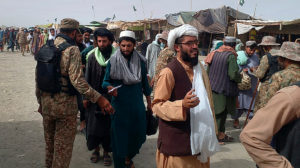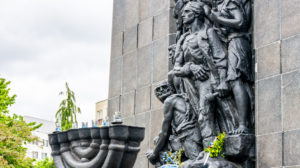Borderline Catastrophe: On Site Report

Mishpacha traveled to the Mexican border to put a human face on the crisis playing out just 500 feet from the US
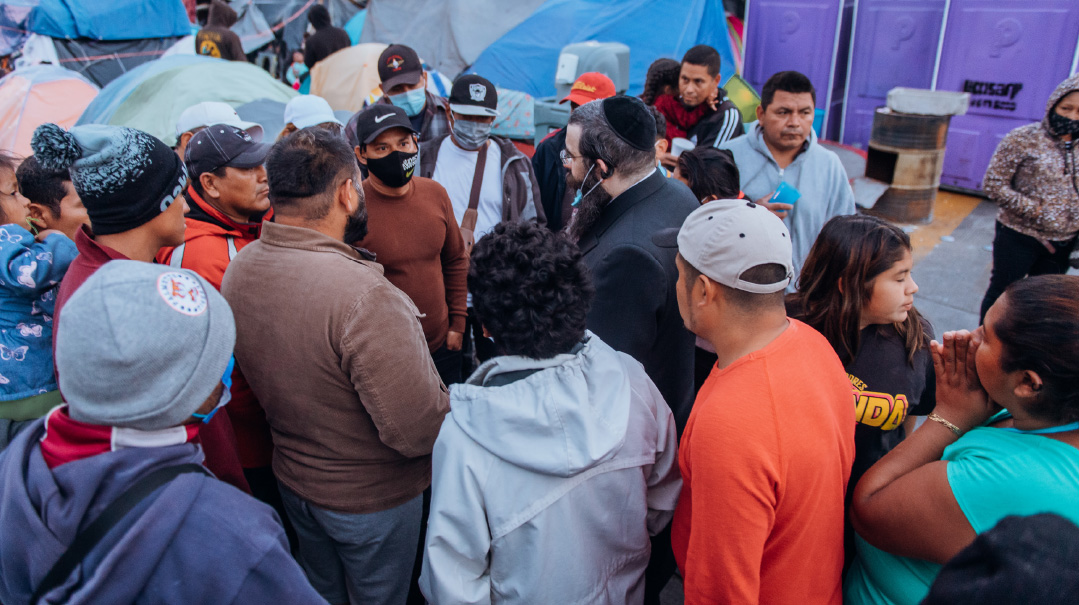
On Site Report by Yochonon Donn, Tijuana, Mexico
Luis Morenas stared at me in disbelief when I asked why he left his homeland of Honduras to spend months in a Mexican shantytown waiting to cross the border into the United States.
“El presidente gave a promise on February 19 that this was going to be open,” he said simply, referring to President Joe Biden. “The president made a promise that he was going to help the immigrants. We are just waiting.”
During an extraordinary visit to Mexico to report on the crisis playing out just 500 feet from the United States, I got a firsthand view of that promise’s repercussions. Contrary to his administration’s denials, Biden’s liberalism, say the would-be immigrants themselves, has acted like a giant magnet drawing thousands to the Mexico-US border — and it’s unclear that the US has the resources to process these huddled masses seeking a better future. For now, they are waiting, in increasingly desperate conditions.
The Mexican border has long been a crisis for the United States, but never more so than during the past three months. Armed with a vaguely worded and misunderstood promise by Biden, hundreds of thousands of Central American immigrants have poured into this border crossing area, called El Chaparral, with bright hopes that Biden would keep his word.
But while everyone agrees these immigrants are suffering, there is sharp dissent in distant Washington, D.C., about the bigger issues surrounding their fate. How many immigrants should the US accept? Are they a threat to the job prospects of hardworking Americans? Are the thousands waiting to enter indeed refugees fleeing powerful Mafia clans — as they claim — or is there a sizable portion who are economic migrants in search of more lucrative working conditions? And however sorry their current plight, how much weight should the US give to the economic and political consequences of unrestricted immigration?
While the politicians and pundits battle out these questions, I set out to meet the human faces behind the issues. Most of the people I encountered are not seeking to enter the United States under the strict immigration quota system; instead they are seeking asylum, claiming that their countries of origin are unsafe.
I had been told that the migrants were suspicious of media and probably wouldn’t talk to me. But after I explained that I wanted to bring their story to Mishpacha’s American audience — Mishpacha means familia, I told them, earning a roll of understanding aahhs — they warmed up. They lined up for hours to tell me their stories, invited me to their tents, offered me the best hospitality they could muster — a chair to sit on — and shared with me their fears and hopes. All these people wanted was to be heard.
“This man,” one of the migrants who spoke English fluently told them, “wants to bring our story to America as a human story, not a political story.”
I was suddenly feeling more like a visiting celebrity than a reporter. Women asked me to bless them, and some asked for prayers for their sick relatives. Standing before the group, I sensed the tension inherent in our collective approach to the politics of immigration, as an increasingly Republican-leaning community, with our own very recent, painful experience looking for a safe refuge.
“Two generations ago,” I addressed the ragtag group of about two dozen people, “Jews were also in this situation, of nobody wanting us. We turned out pretty well in America. Now it’s your moment.”
“Gracias!” they called out, giving me an extended round of applause and shouts of “Whoo!”
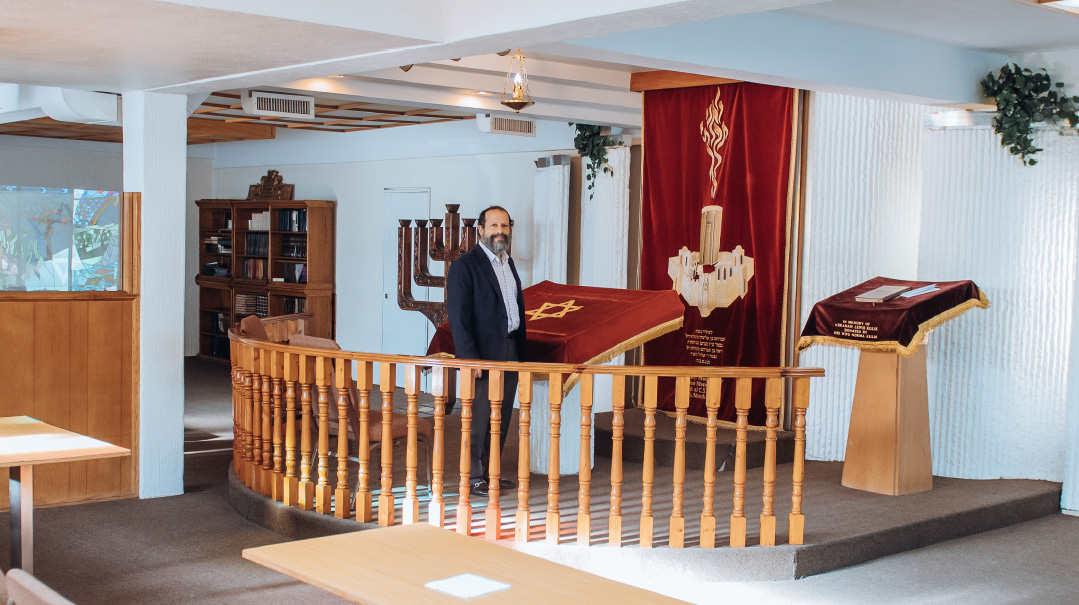
With its vivid skies and faces bronzed by the brilliant sunshine, San Diego is a city wholly unlike my native New York. But it’s also distinct in its own California: The city trends marginally more conservative than the rest of the progressive state because of a heavy military presence; there is a major US Naval base here, and many large Army bases. When I arrived, I had to apologize to my hosts, Rabbi and Mrs. Mendy and Dini Polichenco of the local Chabad, for bringing along a very New York commodity — a rare spring rain.
Born in Argentina, Rabbi Polichenco came to the United States to study in the Lubavitcher yeshivah in Morristown, New Jersey. In 1991 he was asked to come to Tijuana, a city on the Mexican border, for a summer program, and he slowly began spending more time there until he was asked to become the rabbi there. He received permission from the Lubavitcher Rebbe to open a Chabad house in this city abutting the US border, and remained in Mexico for many years while sending his children to learn in San Diego mosdos, half an hour’s drive away. He finally made the move across the border to San Diego six years ago.
One thing I noticed as we approached the border was the street names — the overwhelming majority of them exhibiting Hispanic heritage, such as Via de Ysidro Avenue, Cesar Chavez Boulevard, and Camino de la Plaza. But one boulevard had a distinctly American name: Mile of Cars Way.
“Sometimes there are two or three miles of cars here,” Rabbi Polichenco joked, referring to the border’s infamous hours-long traffic jams.
Indeed, the normal line of cars waiting to get into Mexico — typically day workers who return home at night, or children who are students in schools across the border — was present on this day as well. But Rabbi Polichenco drives to his Tijuana Chabad house once a week, so he knows a trick or two. It didn’t take long before we were in Mexico.
Leaving the United States and arriving in Mexico can be quite a jolt. Bright red trolleys, guided by webs of electrical wires above and crisscrossing steel tracks below, clang slowly through the streets of San Diego, backdropped by the picturesque San Ysidro Mountains, browned by millennia of baking sunrays. Toward the city’s southernmost district, the San Ysidro Crossing, there’s definitely an immigrant feel — its main road is lined with check-cashing businesses and money exchanges, mailboxes and duty-free shops — like a giant airport.
Just across the border, the scene changes. Only yards away from the beginning of the San Diego Freeway, one of America’s most famous arterials, the blinking lights that divide the 12 lanes make way for narrow dusty roads with no separating lines marked. Mothers sit along the sidewalks with their hands outstretched for contributions, their children with their own cups alongside them. A couple and young child sit on the sidewalk, a clothesline full of colored clothing fluttering in the wind as they stare at the US border 100 feet away.
Instead of red trolleys, bright red minibuses traverse the city, picking up passengers. As we stopped for a red light, a Haitian man took advantage to jump into the intersection and juggle three flaming torches, hoping for a coin from drivers.
Lots of medical tourists come to Tijuana, which has a flourishing practice of alternative medicine and cheap elective surgeries. We pass a vision medical facility where a Jewish surgeon fields a global practice of Lasik surgery to repair eyes. Overall, much of Tijuana’s real estate is owned by Jews, and about 250 Jewish businessmen commute every day from California. La Mas Barata (“the cheapest” in English), the local pharmacy chain, as well as the largest medical facility over the border, are also owned by Jews.
A statue of Cuauhtémoc, the last Aztec ruler, executed by Spanish conquistadors in the 1500s, dominates the city square, with his headdress rising defiantly and a tomahawk and shield in his hands.
Tijuana, like much of Mexico, is mired in crime and controlled by the Mafia. But this is a border area, so security is usually tight. Law enforcement is ubiquitous, and we passed a gray, round police station where officers monitor a bank of cameras dotting this sprawling city of three million.
Gang violence is a problem here, but usually doesn’t affect regular citizens who keep away from the gang clubs and restaurants, Rabbi Polichenco tells me. In all his years living in Mexico, he only had two break-ins.
“I feel safer here than I do in downtown Los Angeles at night,” he says.
Until a few years ago, it was common for Mexican migrants to rush the border at night by driving full speed against traffic, with their headlights off. Today, US border patrols have an array of strategies to counter that. Rolls of barbed wire lie near each crossing booth, and yellow stakes are on the road, designed to burst the tires of any car driving against traffic. Trucks with lights and sirens stand at the ready to chase down any border rushers.
Our first stop is at Rabbi Polichenco’s shul, the Centro Social Israelito de Baja California, which is situated in a gated compound. The shul has siddurim with Spanish translations, and in the adjoining social hall we meet a group of elderly men schmoozing in rapid-fire Spanish.
These migrants, it turns out, are not only Hispanic but are also sometimes Jews, Rabbi Polichenco said. He is regularly called on to provide kosher food to the nearby Otay Mesa Detention Center. One person who has been in detention for over a year is a native Russian, to whom Rabbi Polichenco supplies kosher food and seforim in Cyrillic type.
While I was walking around the migrant camp, two people told me they were Jewish and asked for the number of the rabbi. One of them, an older man with swarthy features, wanted to know the address of the local sinagoga.
“My grandmother, she passed Hitler,” he tells me in broken English, meaning that she survived the Holocaust.
The man, who gave his family name as Malat, said that he was Jewish and the grandson of a Holocaust survivor named Abalbela. He came from El Salvador and was seeking asylum.
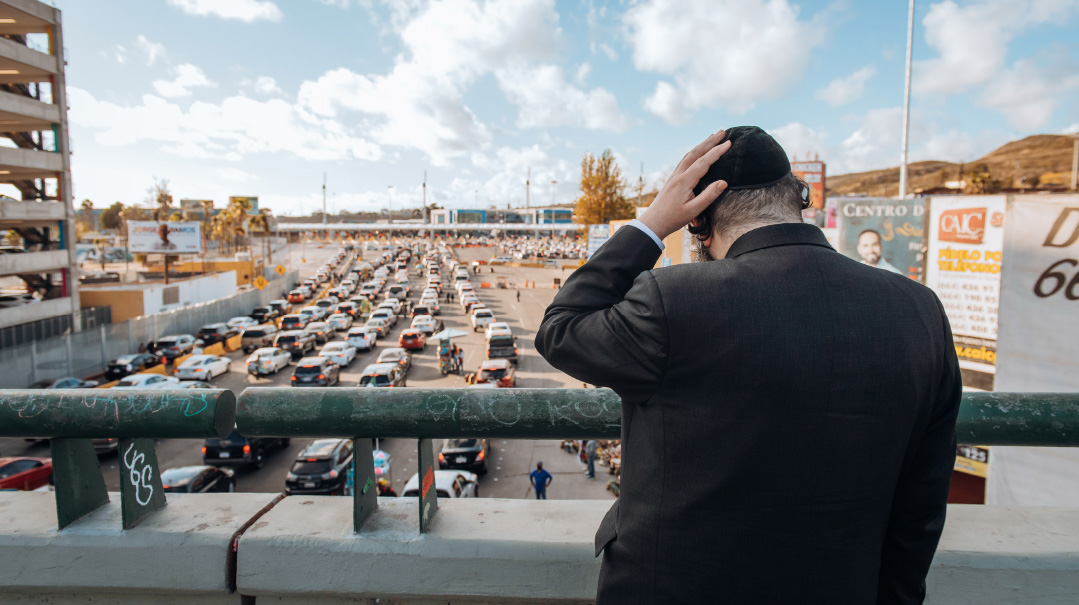
When President Joe Biden signed an executive order ten days into his presidency to allow in migrants applying for asylum, his administration billed it as rectifying the “moral failing” of his predecessor. Trump, they noted, forced refugees to apply for asylum outside the country.
But Biden’s executive order not only ignored the economic and legal concerns of many Americans, it also brought chaos to the would-be immigrants. Tens of thousands of people living in the triangle countries of Latin America’s slim waist — Honduras, Nicaragua, and El Salvador — began the long trek by foot, bus, and train to the land of freedom, convinced that Biden was opening the gates to all. From their villages, pueblos, and cities, people with a hardscrabble history and dreams of raising their children without fear packed their few possessions and made their way north.
In terms of numbers, it’s hard to deny that the border surge is a crisis. In February and March alone, the monthly numbers of migrants arriving at the border exceeded 100,000, a generational record for winter. And for the first time, about 10 percent of them are unaccompanied minors. This compares to January’s 78,000 migrants, and is nearly double the number of a comparable time period last year.
The steam of unaccompanied minors crossing the border is a relatively recent phenomenon. There were fewer than 20,000 a year when President Barack Obama took office in 2009; that leapt to 70,000 when he appeared to ease the pathway to citizenship for illegal immigrants four years later. By Trump’s final year, after his tough quotas and progress on the construction of a border wall, the number had dropped back to about 30,000 a year. But the past two months’ figures threaten to bring the number back up to 60,000 a year.
Yet the Biden White House continues to insist that what is happening at the border is not a crisis. Even when Biden used that very word last month, the White House issued a head-scratching statement that “the president’s use of the ‘crisis’ label doesn’t represent the administration’s official position.”
Further evidence of the current administration’s confused thinking on immigration came in the form of a recent flip-flop. One of Trump’s first official acts after becoming president in 2017 was to limit the number of refugees allowed in outside normal immigration quotas. By the time he left office, that cap was 15,000 a year. Biden, after an outcry when he announced he was leaving that number in place, raised it to 62,500.
To the thousands of migrants packed into subhuman conditions due to what they believe was a promise by the president, Biden owns this crisis. The same way Democrats derided President Herbert Hoover’s handling of the Great Depression by calling the tent cities set up by the newly homeless “Hoovervilles,” these migrant camps on the Mexican border can be termed “Bidenvilles.”
“To me this is a crisis,” said Umberto Ariel, a Honduran speaking polished English from his stint as a call center operator in Texas years ago. He offered his services as a translator during my visit. “These are very, very bad conditions, but Central America is known for its dangerous countries, and because the political situation there is so messed up, what choice do we have but to run away from our countries?”
Not all the migrants are from Central America. Some hail from Mexico, and a few even have close ties to the United States. Maria Ochoa Gallegos, 52, says she is married to a US citizen and has five adult children living on the American side of the border. She went back to Mexico 19 years ago. She now is sick and wants to return to the US but is not allowed to.
Several of the migrants took pains to tell me that they did not join any of the caravans of illegals that stormed the border during the Trump years. Those appeared to have been professionally organized, perhaps to test the president.
Those who came with the Honduran caravan three years ago, right before the midterm elections in the US, were demanding and difficult, Rabbi Polichenco relates. “They didn’t want to take the bread and water we offered them — instead they said, ‘We want pizza and Coke.’ And they left a mess. The people of Tijuana were very upset with them.”
I came at a critical juncture in the migrants’ existence. Most local residents sympathize with these itinerants’ plight: their cities of origin are unsafe, and here, while they wait, they face daily death threats and assaults. One February day early on in their encampment, one migrant tells me, a passing car stopped and the occupants grabbed two of his children, aged seven and ten. It’s been over two months since then, but there’s still no word of their fate.
“This is the situation,” Ariel, my translator, says with a sigh. “If the Mafia sees some of our kids, they kidnap them. And if we have family in the United States, they are going to ask them for money. There is a lot of racism here in Mexico against us. They won’t hire any of us because of it.”
A policeman stands guard outside the encampment, but residents say that he’s not there to protect them.
“He don’t do nothing,” Ariel says.
Many parents stay up all night to keep an eye out for troublemakers.
One teenage boy shows me a long scar that crosses his left cheek, an unpleasant souvenir of a scuffle that broke out the week before. Another shows me a video of the incident — two Mexicans in sombreros kicking and attacking some migrants, before taking the teenager and hurling him to the ground. Apparently, the Mexicans thought the migrants were blocking store entrances near the camp. The migrants explain that in order to draw attention to their cause, they had gone to a shopping area about three minutes’ walk away. Some of the vendors complained and called the police, who chased them away.
“They would never stand for this back in New York,” said one passerby, a woman who lives in Manhattan but visits Tijuana frequently. “The local people are probably so annoyed with what is going on. But it’s like this because there are so many migrants — things are just out of control.”
I visited the site of the attack, and found a newscaster for the Noticias Ya news site, Aranzazu Alvarez, reporting on the incident. The area appeared deserted and was enclosed with yellow crime scene tape.
“Normally, the migrants come, protest, and then leave,” Alvarez told me in Spanish, helpfully translated by the Manhattanite. “On Friday, they were protesting and staying. They are trying to get people to listen to them. All these businesses were having a hard time because these people were in the way and police were not doing anything. So they put up blockades.”
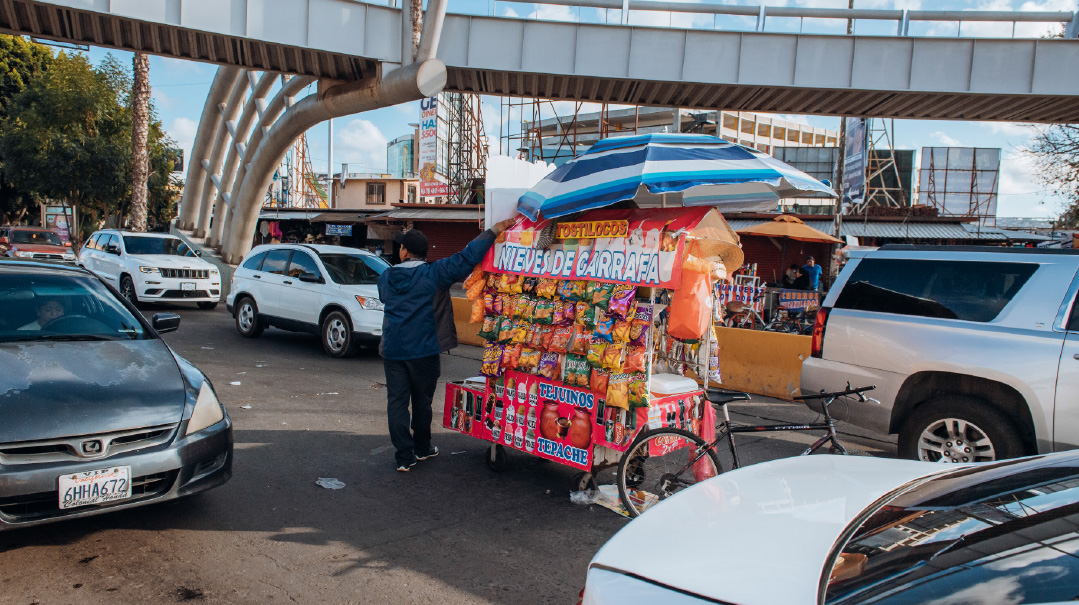
The tent city, about the size of a city block, is the most depressing place I’ve ever seen. Called the El Chaparral migrant encampment, it is partially located under a highway that provides a measure of protection against rain, though not against the cool chill on the day I visited. None of the tents is larger than four feet by five feet, and some house as many as six or seven people. One tent held a family of six jammed inside, the adults curling their legs so they wouldn’t stick out. Another had four generations living together in one square meter — a mother with four children, her mother, and her grandmother. The grandmother, a wizened woman who leaned on her daughter’s shoulder, followed me around, gesturing me several times to come see her “house.”
This particular encampment was established — if the term could be used to describe the array of colored tents pitched on any available ground — by Haitian migrants about a year ago, but was subsequently overtaken by Central Americans.
The nucleus of the camp features blue tarps overhead that allow an average person to walk in without bending over. But that coveted area has just five tents; hundreds of other are covered in blue tarps that continually flapped in my face as I walked around. One of the heads of family laughed when I ask him if his is a VIP tent. Some of the less fortunate campers had to pitch tents between cars parked at a nearby lot.
Six portable toilets stand on the side for approximately 2,000 people. Most of the fights in the group, one person tells me, are over the bathrooms. Peering inside, it is obvious that they haven’t been cleaned in days, if not longer. Three portable showers are not attached to any water stream, meaning that a bath must be done the Victorian way — fill up a bucket and splash.
Food is cooked in small pots that are heated by makeshift ovens. Several families have state-of-the-art gas ovens — which are heated judiciously because a new gas canister cost $10, something they can ill afford. Most of the others use grass, twigs, or wood to build fires.
The tents are placed directly on the ground, with only a thin plastic separating them from the hard concrete.
“It’s very uncomfortable,” Ariel tells me. “It’s very cold at night. Only the lucky ones have blankets.”
The encampment’s residents aren’t very demanding. All they ask for — aside from answers from immigration authorities, of course — are clean bathrooms and medicine for the children.
Every four feet or so, rat holes puncture the sidewalk, their denizens darting out at whim. Kids go to bed late and wake up late in the morning. I watch a young boy, no more than four or five, kick a ball repeatedly against the bridge span. Two other children speed by on scooters, laughing as they splatter through the mud. A baby, only half clad, plays in the mud puddle as he waits.
Waiting. That is what everyone here is doing. This is not like waiting at a doctor’s office or government agency; it’s a full-time job that has already stolen months from their lives. They cannot merely apply for entry and then go home to anticipate a reply. Nealy all of the dozens of people who told me their stories intimated that they had been forced to flee trouble back home.
How is it possible that such misery exists so close to the US border? How can it be that the human rights organizations have not made this a relief priority? Just the week before, the head of Mexico’s Human Rights Commission met with some of the migrants and called for better supplies to the camp. Nothing has changed since then, the migrants say.
Meanwhile, the day after I left Tijuana, José Luis Pérez Canchola, the city’s director of migrant affairs, said the camp will soon be moved to a sports complex a few miles away. Migrants do not want that; their very visibility pressures authorities to allow them into the US.
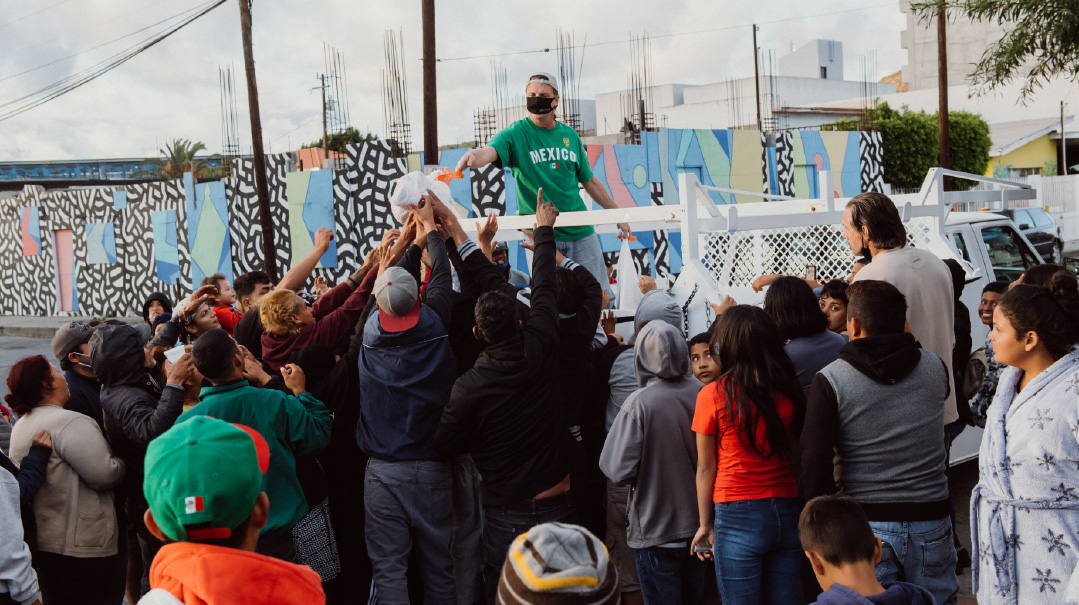
Aid does arrive here, but at unpredictable times. As I was talking to some migrants, a man driving an orange Chevy Camaro stopped his car nearby and began distributing money to the children playing on the road. A few minutes later, a man wearing a Christian symbol pulled up in a pickup truck across the street, immediately attracting a sizeable crowd. He climbed up onto a stage and began tossing out bags to a forest of outstretched hands. One of the women showed me what was in the bags — a loaf of bread and two cans of chili beans.
The woman, who is 17 and the mother of a one-and-a-half-year-old child, is from Honduras. Her story is a sadly familiar one — a victim of domestic abuse, she is seeking asylum. It took her nine months to make her way to the border, and she has been at the camp for four months.
“Where I am from, it is very violent, and here, too, I was almost attacked,” she said. “All I want is the safety of my son.”
Nearly every person I spoke to had that look, as if they’d seen a lifetime of evil in their short time. Most are women and children. Two women standing near the encampment told me they were from Honduras and had walked or hitchhiked here in the wake of Biden’s proclamation two months ago. They were seeking asylum in the United States.
“There’s a lot of violence from organized crime where I come from,” said one woman, who gave her name as Diana. “I started getting death threats.”
She said that during her trek through Mexico, she was detained by police and scheduled for deportation back to her native land. She bribed them with 13,000 pesos — the equivalent of about $650 — and they allowed her to go. Even now in Mexico, she said, she does not feel safe. Only in America will she be able to breathe securely once again, she said.
“The Mafia is a business in Honduras,” Diane said. “People benefit from them. Everything is so corrupt there. It’s never going to stop because the police work for them, not for us. The Mafia pays the cops. MS-13 is so big in El Salvador that they are never going to leave. It’s like saying the Crips [one of the largest and most violent street gangs in the US] are going to leave L.A. — never going to happen.”
Her friend, Saidy Danivi Martini Garcia, was married at 13, had two children by 16, and left her husband at 24 when his abuse became unbearable. During the ensuing custody battle, she began fearing for her life from gang members, so she dropped off her two older children at her mother’s house and fled with her younger son. A year later, she misses the children she left behind, but feels she has no choice — she can’t afford the coyote’s fee to bring them to Mexico.
Now that she’s in Mexico, she wants to apply for asylum in the US for herself and her three children and move to Houston where her sister lives.
“As soon as I cross over to America,” Martini Garcia declared, “I want to go work. I will do anything — anything, anything, anything — to earn money and bring over my two daughters. I’m just waiting for the call.”
Lorenzo Lopez is a tall, thin El Salvadoran, a dark bandanna covering his hair and a mask concealing the lower half of his face. Thirty-five years old, he had a good job as a policeman until he was nearly killed by a gangster. He filed a police report, and was stunned when a counter-complaint was filed against him by the police.
The final straw came when a gang attempted to convince his oldest, a boy of 11 with a mental disability, to join them. Lopez then took his wife and four children and escaped his hometown, slowly making his way through El Salvador and Mexico until he arrived at the border.
“I just want one thing — for my children to be safe,” Lopez said sadly. “I have no plans to go back to El Salvador. I am staying here until they let me across.”
Stories abound, however, about the dangers of the very camps where the asylum-seekers are living.
“It’s not safe over here, but we have each other’s back,” said Rafael, one of the men I spoke to. He added, “There are some well-meaning people who come from the other side to give us food and clothing, but it’s unpredictable. They could come at five o’clock one day and at two the next day.”
“We do have each other’s backs,” Ariel agreed. “If he needs something and he doesn’t have it, he comes to me and I give it to him. That’s what we’re here for. Central American people are very kind and hardworking. This is like a community.”
Ariel’s fiancé and her daughter were in the encampment until a week before, when their numbers were posted and they got permission to leave. They are now in Iowa. He can’t wait to join them.
Rafael, 32, said he fled his native El Salvador two years ago with his wife and two of his children, leaving three children behind, to escape the violence. He is done with El Salvador and will not return, he says resolutely. A short man with a mask covering most of his face, his two sad eyes peeked out to tell a story more eloquent than his oratory could.
He knows nothing of Trump or Biden, Democrats or Republicans. Or the intense debate people like him engender in the United States, for that matter. Neither do many of the other migrants. The crowd that gathered asked me to enlighten them how allowing people into the United States could spark a political fight. I explained that Democrats are considered to have a lock on Hispanic votes, so Republicans don’t want immigrants in.
“It’s sad to say,” I said, “but that is how it is.”
“So Republicans are against immigration?” questioned one person.
“And the man that is president right now,” another wanted to know, “he is a Republican or a Democrat?”
President Joe Biden, I said, is a Democrat.
“And Trump?”
Trump, I said, is a Republican.
Newly educated, the man explained to his friends the political tidbits he just picked up. Now it all made sense — el presidente is a Democrat so he is letting all Central Americans in. The previous president was a Republican, so that’s why the border was closed until now.
Rafael may not have been politically polished, but he wanted his two sons, aged five and ten, to get a good education.
“I am speaking for everybody here,” he said. “When we get there, I want my kids to get a good education, a good job, become professional, have a good life over there. I am going to wait here and not move until we will be heard from the other side. None of us will move from here.”
But that is easier said than done. Few of these people have filled out paperwork to apply for asylum, a complex system cloaked in bureaucracy. Mexican authorities take down the data, submit it to the United States, and then every week post the numbers of those allowed to cross.
“They don’t have a computer,” one person explained. “They sit there with a pen and paper and write down your information and then they pass it over.”
People who cut the line by storming the border — either through joining the caravans that regularly pop up in the news, or by making a desperate dash through the layers of border security and managing not to get caught — are counted toward the quota, pushing down the numbers of those patiently waiting in line. The woman from Manhattan tells me that the security guard who worked in her building is a migrant who first applied for legal entry in February 2019. He is still in Tijuana, waiting his turn.
For now, the migrants are waiting. To them, my parting words — “See you in New York” — carry the same emotional power we feel in “Next year in Jerusalem.” Oblivious to the furious left-right political battle that their presence has triggered, the camp residents just want their stories to be told. And while I can’t judge whether they qualify as asylum-seekers, it’s clear that all dream of entering the United States because it’s the only country in the hemisphere that promises safety for their kids, security for them, and success if they work hard.
Are Biden’s promises a cruel tease, an unrealistic pledge bound to implode? Can the United States chart a path that allows in immigrants without compromising its own citizens’ future? These questions may be occupying the occupants of newsrooms and ivory towers across the border, but in this tent city, the issues are much more basic.
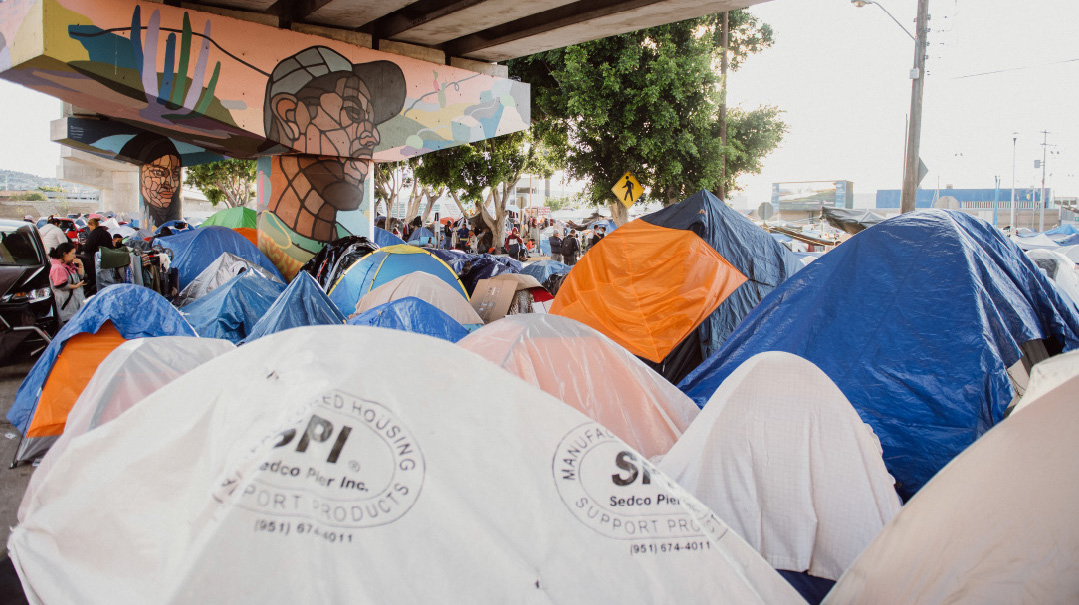
An Immigration Primer
Some frequently-asked questions surrounding the border crisis
How does the current surge in migrants compare to previous surges?
The last time there were this many migrants stopped at the border — 178,000 as of April — was in 2000, when Bill Clinton was president, according to the latest numbers from Customs and Border Protection (CBP). There was a large wave in mid-2019, too, when a buildup of caravans from Central America approached the border. What distinguishes this surge is the sheer number of children coming alone.
The CBP encountered 17,171 unaccompanied migrant children in April, down from nearly 19,000 in March. Single adults accounted for 71 percent of all apprehensions, while families were 20 percent and unaccompanied minors represented 10 percent. That stands in sharp contrast to the 2019 wave, when single adults constituted a much larger percentage of crossers — 28 percent.
How did Trump’s approach differ from Biden’s?
President Trump’s focus was on preventing immigrants from reaching the US. So, for example, he instituted a “Remain in Mexico” program, which required asylum seekers to wait in Mexico until their claims could be heard. He also signed “safe third country agreements” with Guatemala, El Salvador, and Honduras, forcing asylum seekers to first request safety in countries they pass along the way to the US border.
Trump also capped the number of asylum seekers allowed entry at 15,000 a year, a dramatic drop from the 70,000 allowed in during his first year in office. Additionally, escaping gang violence or domestic abuse were no longer considered credible reasons to seek asylum.
Under President Biden, the Remain in Mexico policy was rescinded, leading to a rush to the border. He is also planning on restarting an Obama-era program that lets children from Central America apply for entry from their home countries as a way of deterring them from making the dangerous trek.
How do “coyotes” work?
For most migrants, the choice is between sticking it out until they get their permit, or attempting an illegal entry. People hire “coyotes,” or human smugglers, for a steep fee to guide them from Mexico across the border, usually via the arid deserts of Arizona and Texas or via the sea to San Diego. There are tragic stories every year of coyotes abandoning their clients, or packing dozens of them into hot trucks and leaving them to the mercy of the elements.
What is the difference between legal immigration, illegal immigration, and asylum?
Contrary to what is widely believed, the US welcomes hundreds of thousands of immigrants every year. There is an immigration quota of 675,000 a year, but that figure doesn’t include immigrants in a wide range of classes: people with a close relative (parent, spouse, or child) who is a US citizen; immigrants with unique skills; refugees; or immigrants whose entry would promote “diversity” in the country. There is also an annual global allotment of 50,000 permits given out solely by lottery.
Add all these up and you get to a pretty large number. In 2017, for example, the total number of all types of immigration visas granted by the US exceeded one million.
Some people who do not make it in legally attempt to sneak across the border. They come by air, land, and sea, in shipping containers, vans, and sailboats. There are, very understandably, few ways of ascertaining how many do so, and the estimates of illegal immigrants currently in the country range between the Department of Homeland Security figure of 12 million to the 22 million calculated by researchers at Yale University and the Massachusetts Institute of Technology.
And then there are the asylum seekers, who are also not included in the annual quotas. These are people who appear at an official US border crossing, give their names and their reason for seeking asylum, and are then assigned a court date to appear before a judge — typically months later, or as much as a year. They are then allowed into the country, on condition that they make their court date and leave if a judge rules against them. According to Justice Department figures for 2016, some 9 to 11 percent of them never show up in court.
Why are we seeing a surge in arrivals of unaccompanied children?
Democrats date the lone children coming in droves to the Trump era. Republicans blame Biden for laying out the red carpet for migrants. Neither is completely true.
The number of arrivals of unaccompanied children never reached 5,000 a month under Trump. It is now pushing 10,000, according to the CPB. This is due to Biden suspending a Trump order that allowed the CPB to expel unaccompanied children for health reasons, such as during the COVID pandemic. Instead, Biden reverted to the old rule of requiring border agents to allow them in, no questions asked.
The uptick in crossings was immediate.
“I can’t identify a single other factor that would point to that,” said Art Arthur, a former immigration judge and a fellow at the Center for Immigration Studies. “There’s no other variable besides that.”
“Thank you so much for what you are doing,” Ariel said. “Because all we want is, we want to be heard. All of us, we are full of angustia [angst] and frustration. If you send this message to America or to New York, that would be great, man.”
(Originally featured in Mishpacha, Issue 861)
Oops! We could not locate your form.




